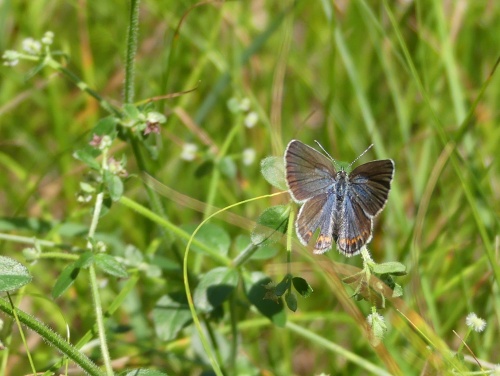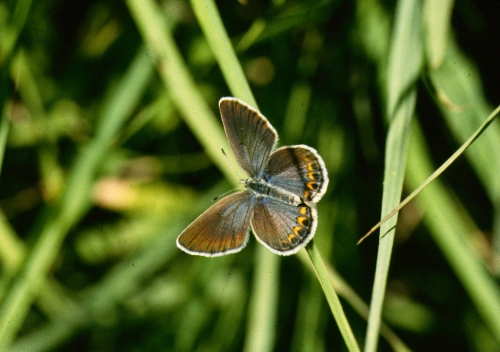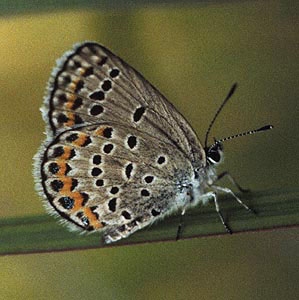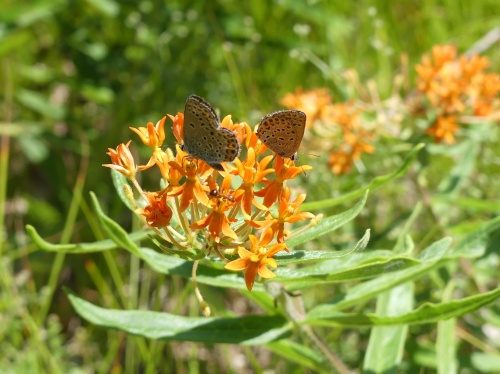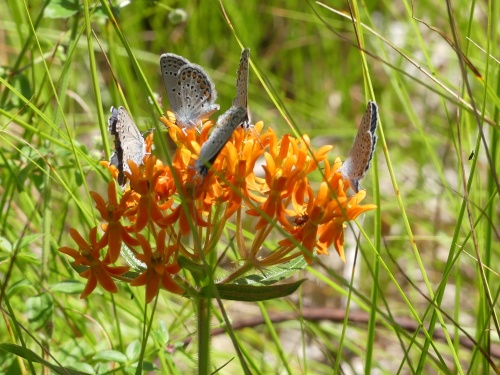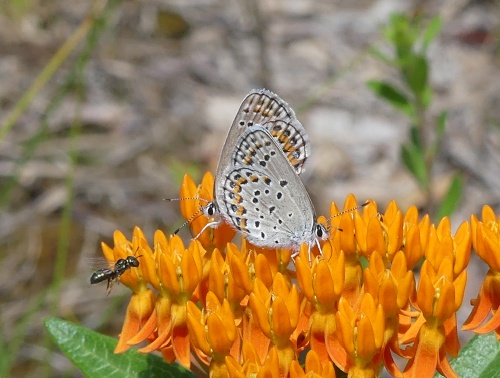Plants and Animals
Plebejus samuelis Karner blue
Key Characteristics
A small silvery butterfly with a 0.9 - 1.3 inch (2.2-2.3 cm) wingspan. The dorsal (top) surface is silvery blue in males with a narrow, dark border and white fringe. Females range from dull violet to bright purplish blue near the body and central portions of the wings; the remainder of the wing can range from light to dark gray-brown. The hindwing of the female also has a row of dark spots with orange crescents along the outer edge. The ventral (bottom) surface of both sexes is grayish fawn to pearly gray with several rows of small black spots on the inner portions of both wings and a row of metallic blue-green, orange, and black spots just inside the outer margin of both wings, becoming less pronounced in the forewing.
Status and Rank
US Status: LE - Listed Endangered
State Status: T - Threatened (legally protected)
Global Rank: G1G2 - Rank is uncertain, ranging from critically imperiled to imperiled
State Rank: S2 - Imperiled
Occurrences
| County | Number of Occurrences | Year Last Observed |
|---|---|---|
| Allegan | 27 | 2025 |
| Ionia | 3 | 2025 |
| Kent | 2 | 2021 |
| Lake | 3 | 2021 |
| Mason | 8 | 2002 |
| Mecosta | 8 | 2007 |
| Monroe | 2 | 2008 |
| Montcalm | 25 | 2024 |
| Muskegon | 37 | 2025 |
| Newaygo | 45 | 2025 |
| Oceana | 43 | 2020 |
Information is summarized from MNFI's database of rare species and community occurrences. Data may not reflect true distribution since much of the state has not been thoroughly surveyed.
Habitat
The Karner blue usually is associated with landscapes composed of sandy soils, which supported oak or oak-pine savanna or barrens prior to European settlement. Since their historical habitat suffers from fire suppression efforts, the butterfly often occurs in openings, old fields, and right-of-ways surrounded by close-canopied oak forest. Karner blue larvae feed exclusively on wild lupine (Lupinus perennis). Adults visit a wide variety of flowering plants for nectar.
Specific Habitat Needs
Openings with lupine needed in: Dry southern forest.
Natural Community Types
For each species, lists of natural communities were derived from review of the nearly 6,500 element occurrences in the MNFI database, in addition to herbarium label data for some taxa. In most cases, at least one specimen record exists for each listed natural community. For certain taxa, especially poorly collected or extirpated species of prairie and savanna habitats, natural community lists were derived from inferences from collection sites and habitat preferences in immediately adjacent states (particularly Indiana and Illinois). Natural communities are not listed for those species documented only from altered or ruderal habitats in Michigan, especially for taxa that occur in a variety of habitats outside of the state.
Natural communities are not listed in order of frequency of occurrence, but are rather derived from the full set of natural communities, organized by Ecological Group. In many cases, the general habitat descriptions should provide greater clarity and direction to the surveyor. In future versions of the Rare Species Explorer, we hope to incorporate natural community fidelity ranks for each taxon.
Management Recommendations
Karner blue subpopulations on sites with extensive lupine are more likely to persist than those on sites with less lupine. Lupine is an early successional species adapted to dry, relatively infertile soils. Shading from tree canopy and competition from sod-forming grasses and sedges have excluded lupine from many former barrens and prairies where it once was common. Consequently, disturbances that reduce tree and shrub canopy cover are necessary for lupine to persist, and under some conditions, occasional disturbances that remove the litter layer are needed for lupine regeneration. Disturbances that may be beneficial for renewing lupine habitat, include prescribed fire, tree removal, and a variety of methods to kill trees and shrubs. Well-planned fire management is an important tool for rehabilitating and eventually maintaining Karner blue habitat. The frequency of fire management should be tailored to each management unit, taking into consideration the desired final community matrix, current community conditions, site characteristics, and the life histories of all fire sensitive species present. On a large scale, the final product should be a landscape complex of barrens, prairies and woodlands at different stages in succession. In this setting, semi-isolated Karner blue populations within the landscape complex would wax and wane as lupine populations changed, and would provide colonizers to sites recently opened by fire or to sites where butterflies have been lost to localized extinction events. Poorly timed or poorly located use of herbicides can have a negative effect on Karner blue butterflies by killing or suppressing lupine or important nectar plants. Mowing between late spring and midsummer is anticipated to have detrimental effects on Karner blue populations.
Active Period
Flight from second week of May to second week of June
Flight from second week of July to second week of August
Survey Methods
The best way to survey for this species is to conduct visual surveys while meandering through habitat looking for flowers and nectaring adult butterflies. A pair of close focusing binoculars may be used to help locate individuals. Most butterfly surveys should be conducted on warm, sunny days with little to no wind.
Visual, aerial surveys
Survey Period: From second week of July to third week of August
Time of Day: Daytime
Cloud Cover: Clear
Survey Period: From second week of May to third week of June
Time of Day: Daytime
Cloud Cover: Clear
References
Survey References
- Martin, J.E.H. 1977. The Insects and Arachnids of Canada (Part 1): Collecting, preparing, and preserving insects, mites, and spiders. Publication 1643. Biosystematics Research Institute, Ottawa.
Technical References
- Evers, D.C. 1994. Endangered and Threatened Wildlife of Michigan. The University of Michigan Press, Ann Arbor. 412pp.
- Herms, C.P. 1996. The endangered Karner blue butterfly (Lepidoptera: Lycaenidae) in Michigan: habitat suitability, potential impacts of gypsy moth (Lepidoptera: Lymantriidae) suppression, and laboratory rearing (masters thesis) Michigan State University, East Lansing. 180pp.
- Pyle, R.M. 1981. The Audubon Society guide to North American butterflies. Knopf Publishers, New York. 924pp.
- Rabe, M.L. 2001. Special Animal Abstract for Lycaeides melissa samuelis (Karner blue). Michigan Natural Features Inventory, Lansing, MI. 6pp.
- Schweitzer, D. 1994b. Recovery goals and methods for Karner blue butterfly populations. Pages 185-193 in Andow, D.A., R. Baker and C.P. Lane, eds., Karner blue butterfly: a symbol of a vanishing landscape. Minnesota Agricultural Experiment Station, University of Minnesota, Miscellaneous Publication, Twin Cities 84-1994.
- U.S. Fish and Wildlife Service. 1992. Endangered and threatened wildlife and plants; determination of endangered status for the Karner blue butterfly. Final rule. Federal Register 57(240): 59236-59244.


